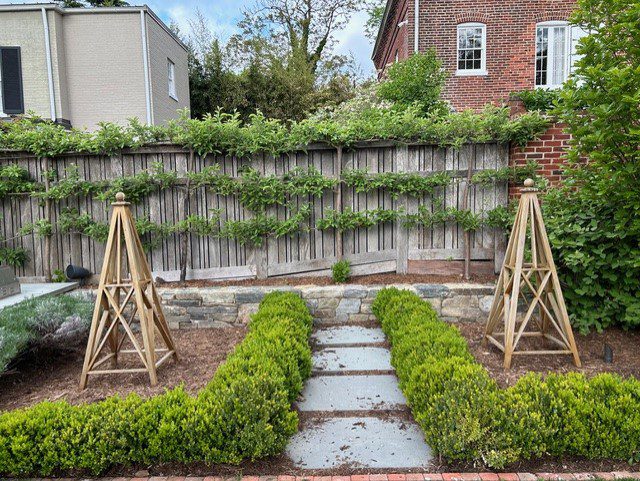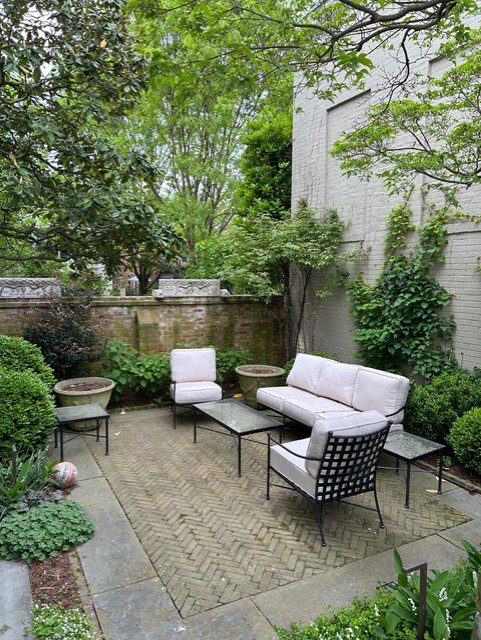By Lee Child and Alison Schafer
This year, the Georgetown Garden Club celebrates its 100th birthday with a garden tour that nods to the past while saluting the future with thoroughly modern design.
Some of the eight gardens on the tour belonged to the famous or infamous (remember John Edwards? Dominique Strauss-Kahn?), some to people with good taste and the money to flaunt it and some to hoary Georgetown cave-dwellers — though these properties in no way resemble caves.
Waiting to please and inspire, each of the featured gardens beckons with docents and gardeners on hand, well-versed in plants, resources and horticultural wisdom. Some of the gardens are defined by expansive spaces surrounding shimmering pools and eating areas; others are more intimate: outdoor rooms that connect with the living areas inside.

Many boast water features, more commonly known as pools, though a few have fountains. One house on the west side of Georgetown includes two statues of the Buddha, one a large head peering out over a mass of hydrangea, another a sitting Buddha watching over an outdoor dining area. That house features flowering pinks and purples framed by two old and twisty juniper trees that wouldn’t be out of place at a hillside temple. Bluestone, in a “piano key” pattern, alternates with bricks, the horizontal layers of pattern on the ground reflected in the vertical layers of plants along the garden walls.
Another garden offers visitors precisely espaliered apple trees. The trees face planting on the garage that comes straight from an English cottage garden: climbing pink roses swooping over purple-headed clumps of catnip. Paths laid with old bricks in a herringbone pattern lead visitors to a multi-trunked Kousa dogwood. The interplay between the house and the garden means snoops can peer into the dining and living rooms through the big windows on the garden.
Yet another, owned by an architect, is packed to the gills with outdoor antiques. The house’s owner uses the bottom of an old balcony as a table. It sits near two iron benches from the 1925 Paris Exhibition, not far from an 18th-century sundial. All of this is framed by a green wall covered entirely in ivy and a 300-year-old Osage orange tree, much older than the venerable Georgetown Garden Club and, indeed, a couple of decades older than Georgetown itself.

Comprising gardens on both the east and west sides of Wisconsin Avenue, the tour provides the perfect opportunity to see the grandeur that is Georgetown, its magnificent parks and historic landmarks, from Tudor Place to the Dumbarton Oaks Conservancy. The latter, accessed down Lovers Lane, is a “wilderness” designed by Beatrix Farrand. It is in the middle of a comprehensive renovation which will take it back to its original opulence.
Founded in 1924, the Georgetown Garden Club may sound reminiscent of old ladies in lace-up shoes and sturdy tweed arranging peonies, but it does, in fact, an enormous amount of work making the neighborhood’s green pockets the beautiful places they are. All proceeds from the tour go directly back into the greening of Georgetown; without the garden club, Georgetown would be an uglier place.
Filled with avid conservationists, the club is responsible for much of the planting and maintenance on Book Hill and in Volta, Montrose and Rose Parks. The Georgetown Garden Club is required to do its work in Georgetown, but its members, like garden club members from around the country, lobby on Capitol Hill for protections for parks and green spaces, push for recycling projects and build green spaces and plant trees in diverse neighborhoods.
Garden clubs support young horticulturists, run programs that introduce children to nature and plant vegetable gardens to get fresh produce to people who need it. The Garden Club of America provides scholarships for budding botanists, urban forestry experts and pollinator researchers, among others.

The Georgetown Garden Club aims to promote greater understanding of the links between plants, environmental protection and community improvement. This work is abundantly evident throughout Georgetown. On May 11, as visitors disappear behind high walls into the secret gardens on the tour, they can thank both the Georgetown Garden Club and their local garden club for all the work they do to make life a little more beautiful.
Gardens on the Tour
2918 P St. NW
3128 P St. NW
1523 31st St. NW
1332 29th St. NW
2613 Dumbarton St. NW
1413 35th St. NW
3323 P St. NW
3327 P St. NW


